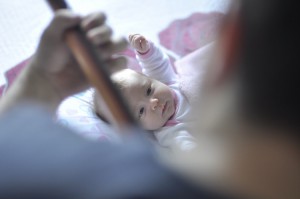
The main thing to remember, according to Nicole Johnson, a pediatric sleep consultant, is that your child’s internal clock won’t be changing with your household clocks. “Our circadian rhythms are very predictable and reliable,” she says. “And they don’t automatically follow daylight saving time changes.” That’s why, if your child customarily goes to bed at 7 p.m., he may seem sleepy and ready to hit the sack at 6 p.m. after the time change. Explains Johnson, “For that child, 6 p.m. feels like 7 p.m., and therefore like bedtime, because it was 7 p.m. the night before!”
As a result, the end of daylight saving can cause even the best and most dependable sleepers to start waking way early, and can lead to crankiness and overtiredness. While a select few parents may actually welcome having their children’s schedule shifted backwards by an hour, most parents cringe at the thought of their little ones waking a whole hour earlier.
According to Johnson, that’s why some prep work is necessary. “If you start early and plan ahead, you can actually shift your child’s schedule ahead of time, in such a way that ‘falling back’ won’t ruin your usual sleep schedule,” she says. If you like your baby’s current schedule, you can prepare for the time change by moving everything ahead gradually: for example, if your baby normally goes to bed at 7 p.m., put him to put 15 minutes later each night for several nights, until he’s going to bed closer to 8 p.m. (you’ll want to shift naps and wake-up times ahead, too). Then, the time change will bump everything back to the usual schedule and you’ll be all set!
If your baby is waking too early, however, that can be very tricky indeed, as the time change will make the wake-up call even earlier. Says Johnson, “I usually suggest that you shift the schedule forward in this case, towards your desired wake-up time.” For example, if your child is waking at 5 a.m., work gradually towards a 6 a.m. wake-up time. After the time change, you’ll be back to a 5 a.m. wake- up call, and once the time change is done, you can work towards 6 a.m. again.
“I know it sounds like a lot of work for something as routine as ‘falling back’,” says Johnson. “And honestly, some families don’t need to do this. If your child adapts well to change, you can simply do nothing and trust that in a few days, everyone will adjust.”
Visit The Baby Sleep Site for more information about preparing for the end of daylight saving time.


